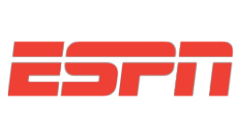
Source: Disney.
A new version of ESPN's flagship program, SportsCenter, made its debut Sept. 7 after the prime-time Ohio State-Virginia Tech college football matchup, and it looked a little more like a late-night talk show than a daily sports highlight reel.
The move to revamp the late SportsCenter is a bold one for ESPN and its parent company, The Walt Disney Co. (DIS 0.93%). SportsCenter has endured as one of cable's best-watched shows without many major changes to the format, even during times when the anchor desk was more of a revolving door.
But with risk comes reward, and this could pay off for Disney and its sports network at an important time.
Though it has held up, the traditional SportsCenter format has an obvious problem moving forward: Highlights are now available almost instantaneously on websites and smartphone apps. The number of people willing to stick around for highlights on their TV sets will inevitably decline. ESPN has recognized this situation. Its digital properties have been the most popular in sports for 17 straight months.
The SportsCenter revamp may be further acknowledgement of this trend.
By looking to hook viewers into something more than highlights, ESPN is banking that it can keep a larger share of its audiences around longer. If the new late-night SportsCenter works, it can go a long way in helping ESPN get the biggest bang for its buck on a number of huge, long-term contracts it entered to broadcast major sports events.
ESPN committed $15.2 billion on an eight-year contract extension to broadcast Monday Night Football. That deal takes the network through 2021. And it paid a premium to get those games. It paid almost twice as much per year for games as did NBC, Fox, or CBS.
With an anticipated increasing number of cable subscribers willing to cut the cord, it's important for ESPN make the most of the contracts it has in place. And one way it can do that is by getting more of those viewers to watch longer.
Two of every three viewers move on
Let's take one week from last football season as an example.
The Dec. 15 Monday night game between the Saints and the Bears drew just over 11 million viewers, the runaway winner on cable that night, with more than four times the audience of the next highest-rated prime-time show, Love and Hip Hop on VH1.
The post-game SportsCenter broadcast drew just under 2.9 million viewers. That's on a par with the nightly audience that either David Letterman or Jimmy Kimmel drew that season, and about three-quarters of the audience that Jimmy Fallon pulled in on The Tonight Show. But it's still less than one-third the audience of the game.
The first episode of the revamped late-night SportsCenter drew less than a quarter of the audience of the Ohio State-Virginia Tech game. But it was still the highest-rated cable show in its time slot, beating episodes of The Family Guy, Love and Hip Hop, and Empire.
Selling Scott Van Pelt
The new late-night edition isn't exactly a radical departure from the flagship show. Highlights and scores from important games still rule the top of the hour. But beyond that, it starts to look more like one of the late-night network talk shows it's competing against.
In its debut, host Scott Van Pelt had a sit-down interview with Dan Patrick, the ESPN expatriate who was once arguably the network's most recognizable anchor. There are bits and off-beat segments, and advance promotion of the show played up host Van Pelt's appeal.
Big sports, big money
ESPN is a massive part of Disney's business, and its largest single property. For some perspective, Wunderlich Securities last year estimated ESPN's stand-alone value at more than $50 billion. As of the Sept. 9 market close, Disney's market cap was $175 billion. And Disney is a diversified entertainment company, operating TV networks in broadcast and cable, movie studios and animation, theme parks, cruise lines, stores, and licensed products.
The sports network is a major reason that over the past 12 months, Disney's media division generated 50% of the company's revenue and 52% of its income.
But in an era where cord-cutting is expected to accelerate, big, long-term deals to broadcast sports could end up hanging around Disney's neck like the proverbial albatross. The transition for some subscribers from cable to a stand-alone sports offering won't be simple and tidy.
Reportedcost-cutting at the network could help bridge the gap to an eventual stand-alone ESPN offering. So will making the most from the contracts for big-time sports broadcasts, and holding on to those viewers longer is one way Disney can do that.
